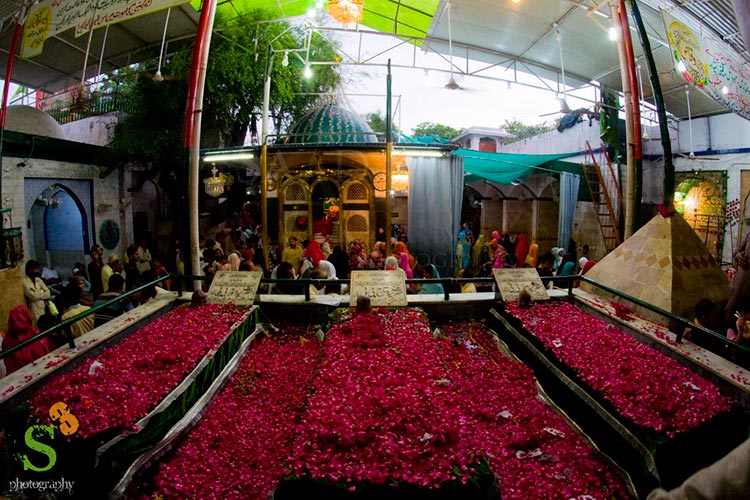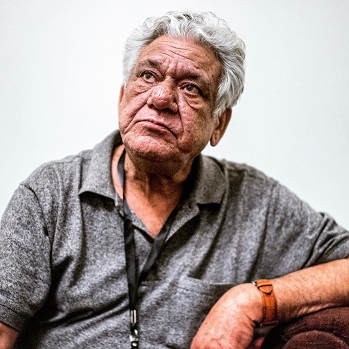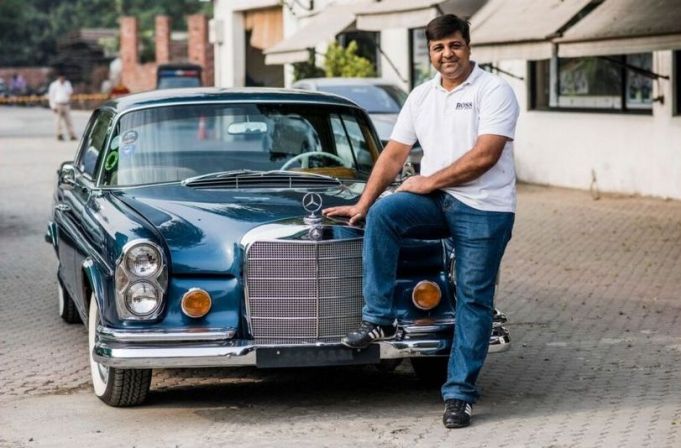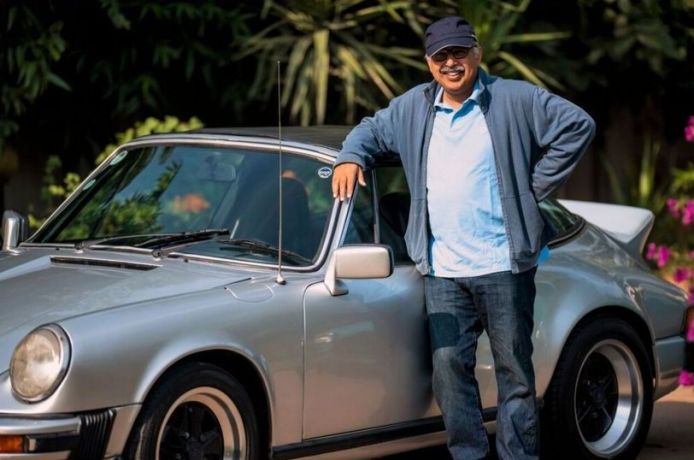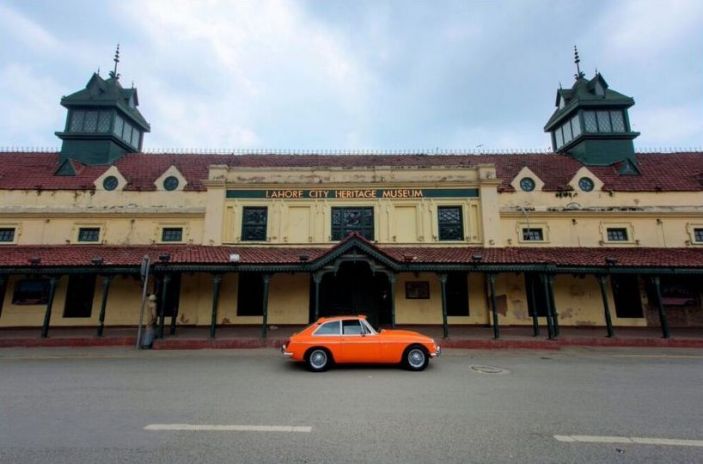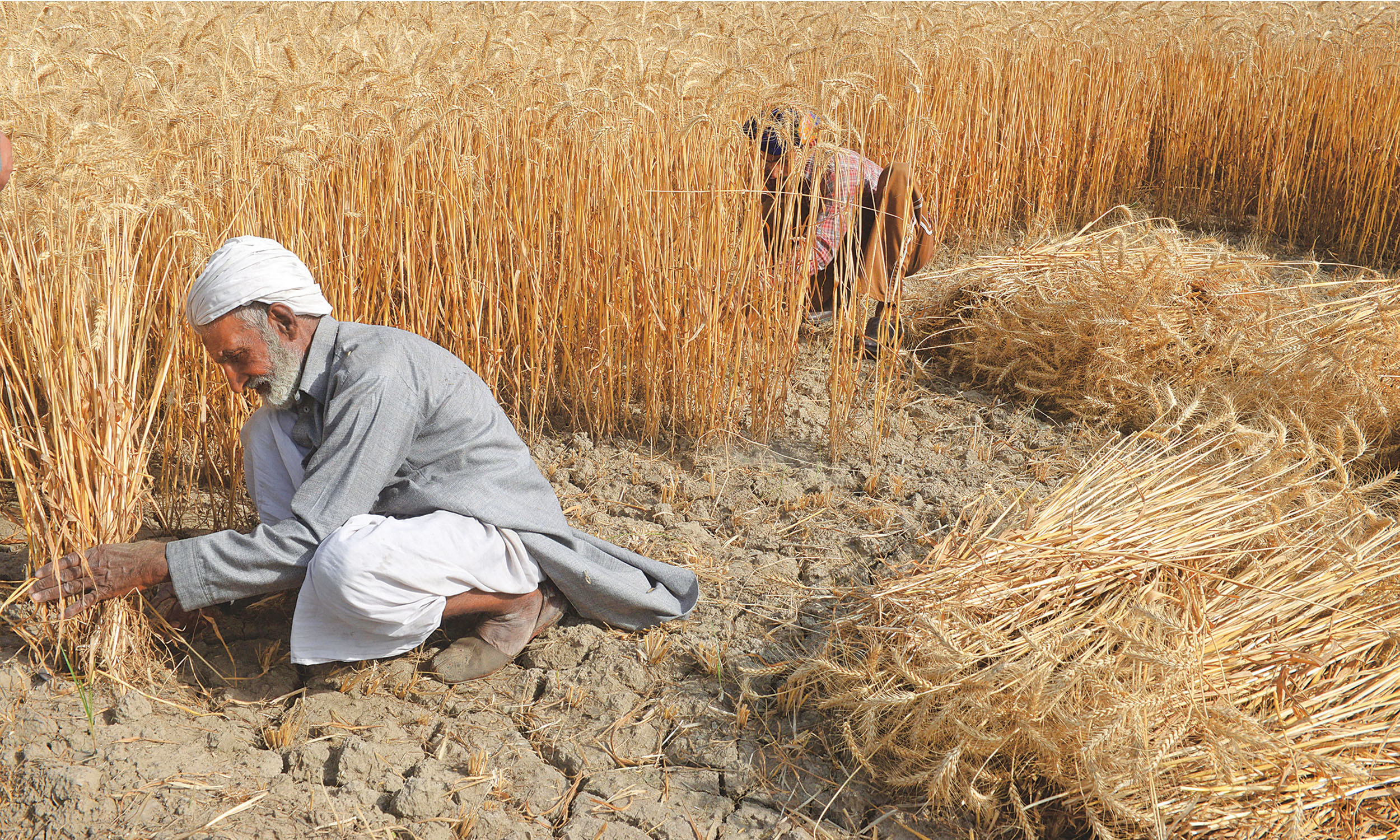
Izzat Majeed is a man of a few words. At first, his monosyllabic answers can rub you the wrong way, particularly if you’re a little on the sensitive side. You might think he’s either being dismissive, or that he thinks your questions are a little stupid. Seated behind a large desk in the office of his three-storey recording studio and rehearsal space, the vibe is of a man who doesn’t have time for casual banter. He’d rather be in the studio, listening to, and making music.
Framed images of the great legends of jazz line the walls as you walk up the stairs at the Sachal Studios, a name inspired by the great 18th Century Sufi poet Sachal Sarmast, from Sindh, Pakistan. There are also pictures of Majeed’s jazz ensemble, the Sachal Studios Orchestra, performing at concerts overseas. One in particular stands out. Hanging just outside the recording studio in the basement, it shows the group, along with Majeed, standing on stage with Wynton Marsalis, the world-renowned jazz composer and current artistic director of jazz at the Lincoln Centre in New York, along with members of the Jazz At Lincoln Centre Orchestra.

There is something special about the studio, but this is not apparent while driving to it. Weaving through a slender, meandering, busy commercial street in Lahore, Pakistan, lined with greasy car workshops, offices and shabby residences, the studio looks like any old commercial building, but once you’re inside, the energy shifts.
It is here that some of Pakistan’s most skilled, veteran classical musicians spend their time, jamming and recording in a space that was set up with assistance by engineers from London’s legendary Abbey Road Studios. It’s a state-of-the-art, custom-designed space that has produced some of the most unique fusion music by way of the Sachal Studios Orchestra, which has married the genres of traditional eastern classical and jazz into a disarming and exciting amalgamation of melodies.
The group broke into the limelight in 2011 with a tabla and sitar-infused cover of Dave Brubeck’s 1959 hit single, “Take Five”. Their version, a perfect marriage of South Asian classical and Western jazz, garnered a million hits on YouTube, while their first album, Sachal Jazz: Interpretations of Jazz Standards & Bossa Nova,which followed that same year, was a best-selling, number one album on the iTunes jazz charts on iTunes.
The great Dave Brubeck, who died in 2012, heard that cover in the final months of his life. So moved was the American jazz pianist that he wrote to Majeed, stating: “This is the most interesting and different recording of ‘Take Five’ that I’ve ever heard.” The quote is framed in Majeed’s office along with another snippet from Brubeck’s correspondence: “Listening to this exotic version brings back wonderful memories of Pakistan where my Quartet played in 1958. East is East, and West is West, but through music the twain meet. Congratulations!”
That Majeed is proud of this letter is even less surprising given that he attended Brubeck’s famed Pakistan concert in 1958, during his Jazz Diplomacy Tour. The performance was held at the then trendy hotel, Nido’s, on the quaint Mall Road in Lahore and it made a lifelong impact on Majeed. It was there, at the age of eight, seated in the packed concert hall, that Majeed began a six-decade love affair with jazz.

Today, the Sachal Studios Orchestra stands as the only orchestra in Pakistan that plays live and tours internationally. The ensemble has collaborated thrice with Marsalis and has performed to audiences on a tour that included London (at the Royal Albert Hall, the Queen Elizabeth Hall and the Barbican Centre), France (the Marciac Jazz Festival), the United States (at the Lincoln Centre, in New York), Japan (the 15th Tokyo Jazz Festival) and India, together with numerous performances on home turf, including TEDxLahore, the Lahore Music Meet fesival and at the Pakistan National Council of the Arts. The ensemble’s repertoire straddles the jazz and South Asian classical genres, with numerous curveballs in between, from covers of R.E.M (“Everybody Hurts”), to Dave Grusin (“Mountain Dance”), Antonio Carlos Jobim (“The Girl From Ipanema” and “Desafinado”), Burt Bacharach (“This Guy’s In Love With You”), and Henry Mancini’s “Pink Panther Theme”, to The Beatles’ “Eleanor Rigby” and more. (Pro-tip: search YouTube for Wynton Marsalis and Sachal’s collaboration on John Coltrane’s “My Favourite Things” at the Marciac Jazz Festival in 2013.)
The Pakistani Oscar-winning filmmaker, Sharmeen Obaid-Chinoy, made a documentary, Song of Lahore, about Sachal’s musicians. It premiered at the Tribeca Film Festival and had a host of other international festival screenings, including Dubai. Along with the international press attention, the orchestra from Lahore has quickly made a name for itself on the jazz map of the world.
***
An economist by profession, Izzad Majeed started out his career in the 1980s, in the Middle East, in Riyadh, as an advisor to the Minister of Petroleum & Mineral Resource. Later on, he worked with a Saudi partner as an investor. But his love of music remained unfailing throughout his successful corporate career. However, it needed to be taken a step further to achieve anything of lasting value, hence, years later, Majeed decided to put his money to good use. Thus, Sachal Studios was born in 2008.

Majeed’s affiliation with music wasn’t a random, newfound hobby. His earliest introduction to jazz came several years before seeing Brubeck on stage when Majeed was only five-years-old. He recounts his earliest recollection, sitting on his father’s lap while Majeed Sr composed the music score for a film. Mian Abdul Majeed was chairman of the Film Producer’s Association of Pakistan and his home was frequented by a number of musicians, including the late, great Indian classical musician, Ali Akbar Khan. Consequently, music and lyrics were an unending thread throughout Majeed’s early years growing up amid music and film in the company of some of the greats.
His mother, Seeta, on the other hand, hailed from a prominent family in India. She met Majeed’s father at Ludhiana College in Delhias students, they fell in love and eloped. During that time period, the marriage between a Muslim and a Sikh was nothing short of scandalous; it would never have been allowed had they asked for permission.
“The story of music in Majeed’s life starts with both his parents,” says Nur Fatima, the CEO of Sachal Studios and also Majeed’s wife. She’s sitting beside him in the office discussing her husband’s early inspirations. “Did you know he was temporarily thrown out of Oxford University for three months for blaring Marvin Gaye’s “What’s Going On?” from his dorm window,” Fatima reveals, speaking about her husband’s obsession with music, while chuckling and looking over at him teasingly as he grins. Thankfully, Majeed was allowed to return to Oxford where he completed his Masters in Politics, Philosophy and Economics in 1972.

“Initially when he launched Sachal Studios, it was with the intention of bringing organic music back to Pakistan,” Fatima continues. “He found the electronic ‘noise’ of these times to be too monotonous; he says it’s like stuffing yourself on processed food as opposed to home-cooked food that’s made from scratch. When you’re playing an instrument, part of your heart and soul is in it, so the sounds you produce are human.”
Having been silent so far, Majeed interjects: “Do you know what jazz is? You have to understand that jazz is exactly the same as our classical music; the structure and foundation is very similar. In our culture, in classical music, you’re stuck to a particular road regarding ragas [scales in classical music], and in jazz, it’s the same thing.”
But is there still a demand for classical music in Pakistan? “I don’t care,” Majeed replies briskly, elaborating that he’s in it for the love of music and nothing more. Revealing that the orchestra is far from financially viable, Fatima says that the orchestra was, and is, by no means a “business”.
“It was never envisioned like that,” she clarifies.
While the orchestra has made its presence felt in the jazz circuit overseas, Sachal’s music isn’t mainstream in Pakistan yet, primarily because it hasn’t taken the commercial route. What Majeed would rather do is explore this space between the South Asian music of his region, and the jazz sounds he also grew up with. He is currently working on a project to host Pakistan’s first-ever jazz festival in Lahore, this year, which he hopes will feature a number of musicians from around the world.
But more than the music itself, the story of the Sachal orchestra, and the man behind it, is this: some of Pakistan’s most established classical musicians were given a second chance at their once flourishing careers thanks to Majeed.
In the 1970s, the Islamisation of Pakistan, driven by the then military dictator and president of the country, Zia-ul-Haq, from 1977 until his death in 1988, resulted in the rapid obliteration of art, culture and tourism. Until then, the country had been popular in the 1960s and 70s with tourists as part of the famed hippie trail from Europe through to Asia. Celebrities such as Ava Gardner, Marlon Brando, Quincy Jones (and Dave Brubeck), among others, visited at various stages and the local ‘Lollywood’ film industry produced 100 films per year at its peak. This all changed with Zia’s concoction of heavy censorship laws and new tax rates, which swiftly changed the face of a young, promising nation on a roll. Suddenly, artists who once thrived in their fields of music, film and performance, found themselves unemployed and redundant. The outlets for creativity were barricaded, and those who kept their kitchens running on their art alone, quietly recoiled into obscurity and poverty.

“When the film industry finished, the music stopped,” Fatima says, mentioning that a number of musicians she knew had little choice but to give up on their dreams and resort to menial jobs such as selling knick-knacks, vegetables and working at roadside tea-stalls. “Can you imagine a violinist working as a security guard?” she says with disgust of the ways that once illustrious and highly regarded musicians had to replace their lost incomes. “Sachal was created with the sole intention of bringing the masters back.”
Further elaborating about the dismal state of affairs of some of the musicians, Fatima states that once, when Majeed handed a brand new cello to the group’s cello player, he broke down into tears and asked Majeed if he could take the instrument home to practice playing again.
Though the trend toward religiosity in Pakistan has continued, Majeed and Fatima say that there has never been any fundamentalist opposition to their music. “There’s never been any such threat or incident in Pakistan,” says Fatima. “The only threat we did face was from the Shiva Sena [an Indian far-right regional political party] who barred us from performing in Bombay in the winter of 2014. Imagine being in a sold-out auditorium, with over 900-plus people in attendance, and being told we couldn’t perform! We were on stage and the curtains never opened, it was terrible. Majeed was so upset that he cancelled the rest of our India tour and we promptly returned to Pakistan.”
During Sachal’s conceptualisation stage, one of the first musicians that he brought onboard was the late composer and violinist, Riaz Hussain, who Majeed states was his “mentor.” It was Hussain who developed the Sachal group, by bringing together a diverse bunch of musicians, all virtuosos with decades of experience of working in the Pakistani film industry. Sadly, Hussain lost his life to cancer in 2014. His death came as a huge blow to Majeed, but it was his passing that encouraged Fatima and her husband to instigate the Alif Foundation to help provide health coverage to the musicians and their families of traditional music in Pakistan.
***

Current members of the orchestra are fulsome in their praise at having the chance to play music. Najaf Ali is one of Sachal’s percussionists who plays the dholak, a two-headed hand drum, and another percussion instrument known as the mridangam. He has been playing music for over three decades and worked in in the Pakistani film industry in its heyday, playing with Nusrat Fateh Ali Khan and another Pakistani singing legend, Noor Jehan.
“There are very few people in Pakistan who are playing pure classical music,” he says during a break from rehearsals, and sitting with his bandmates. “No matter where we travel as our country’s ambassadors – the world must know that Pakistan is home to immense talent.”

Speaking of Pakistan’s bygone golden era of film and music, Ali quotes Noor Jehan, whose singing and acting career spanned more than six decades from the 1930s to the 1990s. “She used to say that her musicians were her wings and that she’d fly because of them,” he sighs wistfully. “But that period of Pakistani music, what it once was, has gone.”
“There’s no industry anymore,” elaborates Ijaz Hussain, who is commonly known in the local music circle as Baloo Khan. He plays the tabla, a South Asian percussion instrument, like his father, Tafu Khan, who is often been touted as Pakistan’s master tabla player. “Now our industry is Sachal Studios.”
Earlier, Majeed had mentioned that having taken members of the orchestra to London’s Royal Albert Hall for the very first time, his musicians were moved to tears while watching the symphonies being played live on stage. “I’ve been playing music for fifty years,” Hussain says while lightly tapping a rhythm across his tabla. “I’ve travelled the world, but the respect that I’ve received overseas is predominantly due to Izzat [Majeed]. The mix of classical music – a genre we’ve been so used to playing in the film industry – and jazz has created an epic atomic bomb!”

“We’re here and performing on the world stage because of Sachal,” agrees Rafiq Ahmed, who plays the naal, a wooden, two-headed drum. Ahmed was only 17-years-old when he began playing solo performances for Lollywood films back in the day. “But for all of this didn’t start instantly – it took a good two or three years for us to understand jazz music. During that time Izzat made us become familiar with the genre. When I first heard jazz it felt so different – it was a big change for us. But when that change began within us, it became something very unique and we were able to translate it into our performances.”
“We’d only heard of George Michael and Michael Jackson. Jazz was a completely new genre for us,” Hussain interjects, while continuing to tap a few beats, his thick fingers working quickly and expertly across the instrument’s surface.
However, when the musicians finally got around to understanding and becoming comfortable with the genre, performances were a breeze, usually extending up to 20 to30 minutes after the last number because the audiences didn’t want the music to stop. “The most exhilarating routine for us was at Lincoln Centre in New York where we played to a packed audience for two nights, back to back,” Ahmed states enthusiastically. “I remember once when we were rehearsing with Wynton Marsalis, he told Izzat, ‘These people aren’t musicians, they’re magicians!’” Ahmed laughs, his words not carrying a trace of conceit, rather, amusement.
“You know, we never thought Pakistani audiences would like Sachal’s music,” Ali says, “but we were shocked by the appreciation after performing in Pakistan – it was very surprising. It made us realize that the audiences in the east and the west are identical in their appreciation of classical-jazz fusion music.”
Thanks to Majeed’s funding, and his commitment to the group, the Sachal ensemble is able to survive in the midst of a now almost totally defunct Pakistan classical music industry. Hussain states that the local music scene could only be resuscitated if the youth had teachers to learn the craft of music from. And while Pakistan is home to some of the best classical musicians, the skills are not being passed down due to a lack of music academies in the country. “In this field, you’re a student for life; look at us, we’ve gotten so old in this field – today’s youth don’t have the patience anymore, they think they’ve made it just by growing out their hair and playing the guitar.”
As the conversation peters out over the next few minutes, the musicians begin dispersing. They’ve been in the studio all day rehearsing non-stop and now they must return home for some rest. Tomorrow after all, is another hectic day of recordings and rehearsals as they gear up for their next routine – creating a bridge between cultures with their beautiful, timeless, and inventive sounds.
Originally Published in Esquire Middle East:
https://www.esquireme.com/content/23502-sachal-studios-orchestra-the-jazz-musicians-of-lahore
